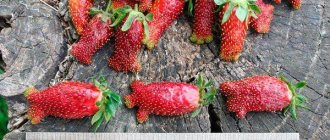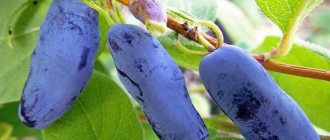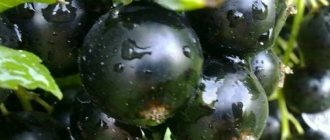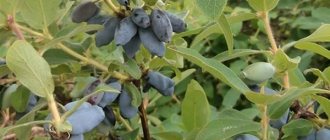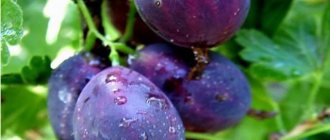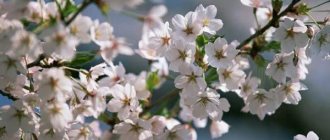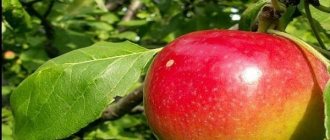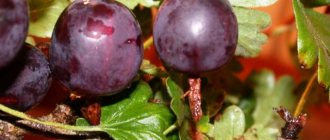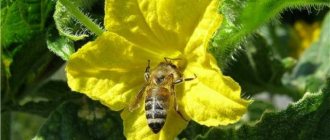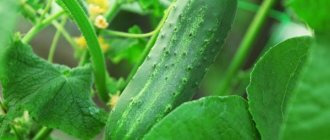Characteristics of the variety
The Elizabeth table blueberry has characteristics that characterize it in different ways. Its strengths can be determined by its fertility, area of application, and resistance to climatic changes.
Berries
According to the description, the Elizabeth variety is characterized by tasty berries that are round in shape, but slightly flattened on top. The fruits are bright blue in color with a predominant bloom. The size of each berry is 20 mm, in the best years the yield reaches 22 mm. The berry cluster is neat, below average size.
Flowering period
A warm spring precedes early flowering; already in mid-May the entire crown is strewn with tassels with white bells. The white background of the flowers has pinkish veins. In the middle zone and in the northern regions, flowering is postponed for a month and falls in the first ten days or mid-June.
Ripening time
Productivity begins in the 5th-6th year and gradually increases the number of fruit shoots. The first fruits appear in August and continue to sing actively throughout the month.
Areas of application of berries
Due to their attractive taste, Elizabeth blueberries are widely used in cooking. They are often consumed fresh, and various preparations are also made. These include: jam, preserves, mousse, compote, kvass, wine, marshmallow. In baking, blueberries are used to fill pies, muffins, cakes, or they are used to make decorations from the berries.
Resistance to diseases and pests
The immunity of the Elizabeth shrub plant is considered strong; blueberries cope with many fungal diseases. The most vulnerable places are the root system, stems, and leaves. Due to high humidity, the plant suffers from late blight and is susceptible to spotting. Common pests are insects in the form of butterflies, caterpillars, and worms.
Taste and medicinal properties
Full ripening of Elizabeth blueberries guarantees a colorful taste with notes of blueberries, grapes, and currants. According to the description of summer residents, the berry is famous for its sweetness, moderate acidity and pleasant aftertaste. Elizabeth blueberries have long been in demand in medicine, cosmetology, and among traditional healers. The berries contain vitamins P, E, A, C, B, useful minerals and salts.
See also
Description and characteristics of Toro blueberries, growing rules
Read
Its main medicinal properties are expressed in increasing concentration, relieving inflammatory processes, lowering body temperature, and strengthening capillaries.
Transportability
Elizabeth blueberry fruits are easy to remove from the brush, which does not damage the skin and pulp of the berry. Transportability is good, but fresh storage is relatively short.
Description
Elizabeth highbush blueberry is a mid-late ripening variety. In the southern regions it ripens from the second half of July, in other regions from the end-beginning of August. It is a tall, vigorously growing shrub. There are many shoots, they are of medium thickness, green with a reddish-brick tint, the laterals (fruit branches) are brick-red. With age, the stems become woody and turn light brown. Elizabeth's side shoots branch strongly to the sides and deep into the bush. Therefore, these blueberries take up quite a lot of space in width, which must be taken into account when choosing a planting scheme. The variety requires regular and careful pruning. Propagates well by green cuttings. The stems are upright, but spreading, generally 1.5-1.8 meters high, the width of the bush is up to 1.5 meters. The habit is elevated and open.
The leaves are dark green, medium in size and oval in shape, pointed at the ends. They are smooth, dense, with a slight glossy sheen. By autumn they acquire a yellowish-red color. The root system is fibrous, well branched, without hairs that absorb nutrients from the soil. It grows shallowly, up to 30−40 cm. The variety is sensitive to the required acidity of the soil, it should be at a pH level of 3.5−4.0. The flowers are white, bell-shaped, 1-1.5 cm long, with small teeth curved back. Elizabeth is a self-pollinating blueberry, but cross-pollination with other varieties blooming at the same time is desirable. This allows the fruits to be of higher quality, tastier and larger in size. The plant blooms in the second half of May and the first half of June, depending on the growing region.
The berries are of high quality, dense, round, slightly flattened, medium-sized and large, sometimes simply huge. Their size varies from 1.6 to 2.2 cm in diameter, sometimes up to 2.5 cm! The fruit weighs 1.6−2 grams, but can reach 2.4−2.7 grams. The skin is thin but elastic. The berries are collected in loose, loose clusters. Ripe ones are easily removed from the bush with a characteristic sound when the tail is torn off; the scar after harvesting is dry and small. Elizabeth fruits ripen quickly, but the harvest period is relatively long (usually 2-3 weeks). After ripening, blueberry fruits hang on the bush for a long time without falling off.
The berries are deep blue, evenly colored, with a dense light waxy coating. What is characteristic of the variety is that unripe fruits are green with a reddish-milky tint. Miss White's efforts were not in vain. The berries really have a rich, soft, sweet taste. It is bright, multifaceted, with currant and grape notes. Sugar and acid are perfectly balanced, no astringency is felt. The fruits also have a persistent pleasant aftertaste. The strong, thick aroma only emphasizes the sophistication of the taste of the berries. According to many experts, and even ordinary gardeners in Europe and America, Elizabeth is the best variety in terms of tasting characteristics from the group of mid-late varieties. And Miss White herself, in an article in the New York Times, considered the taste of these blueberries to be exquisite. The berries are high in vitamins and antioxidants.
Advantages and disadvantages of the variety
The positive and negative aspects of evaluating the Elizabeth variety will tell connoisseurs of shrub crops how to properly organize plant care. Main advantages:
- one of the best varieties in terms of taste;
- relatively fast fruiting, depends on agricultural activities;
- uniform fruit ripening;
- high frost resistance up to -30 degrees;
- culture is not afraid of sudden changes;
- resistance to fungal diseases;
- good transportability;
- use of berries in cooking, medicine, cosmetology;
- stable stalk, fruits do not fall off during the harvest period.
The reverse side of the Elizabeth variety shows:
- low yield figures;
- susceptibility to return frosts during the flowering period;
- in the northern regions, with a short summer, the berries do not have time to ripen;
- The storage period is short.
Elizabeth's Strengths
- Large and very large beautiful berries.
- One of the best varieties in terms of taste and aroma - the berries are sweet, the taste is multifaceted, rich, with a persistent aftertaste. The aroma is thick and rich.
- Good yield.
- Resistance to major blueberry diseases.
- The fruits are transportable over long distances, but it is advisable to use shallow containers and refrigeration after collection.
- Good frost resistance of the variety.
- The versatility of fruit use.
How to plant correctly
Elizabeth's blueberry in the past has the roots of a wild plant, which indicates its unpretentiousness in agricultural care. But still, some features are highlighted, expressed in planting, soil, and choice of planting material.
Recommendations for choosing deadlines
Planting material for the Elizabeth blueberry variety is planted at the end of April or at the end of September. It depends on the region and on the quality of the young plant.
If the seedling is not strong, then it is planted in the spring so that the roots become stronger over the summer. If the plant is strong and tall, then in the fall.
Requirements for location and soil
The Elizabeth blueberry variety loves the warmth of the sun. Strong winds and predominant shade should be avoided. The site is chosen on a hill; it is important that tall trees in the area do not block the sun’s rays. Elizabeth blueberry is a self-pollinating plant, so it will keep company with shrub trees in the garden. For example, currants, gooseberries, decorative cherries.
Site selection and preparation
For Elizabeth blueberries, a site with soil is selected with a sufficient amount of acid, moisture and good air availability. The soil is dug up well, peat, river sand, and soil from coniferous crops are added.
How to select and prepare planting material
You can purchase planting material in specialized stores, nurseries, and garden outlets. This will help avoid mis-grading of goods. According to the standard, seedlings are sold with a closed root system, planted in a container. Here they pay attention to the soil in the container; if it is fertile and moist, it means the roots are productive.
Externally, you need to inspect the shoots and leaves for damage. Also evaluate the color saturation, which characterizes the health of the Elizabeth seedling.
Planting scheme
To plant the Elizabeth blueberry variety, you will need to dig a hole 60 cm deep, 10 cm in circumference, with a distance between trees of 2 m. A layer of crushed stone, pebbles, and pieces of brick is laid out at the bottom of the hole. If the seedling is in a container, then water is poured into it and only then carefully removed. Next, they are placed in a hole, covered with prepared soil, to which mineral fertilizers are first added. They compact it, make a trunk ring, and water it with water at room temperature.
Landing rules
The key to a good harvest is the planting material itself, as well as compliance with all planting technologies . When purchasing a seedling, it is important that its root system is closed and not too dry. You need to pay special attention to the above-ground part. Leaves and shoots should not be stained or dry. Such a seedling will most likely simply die.
Video: Proper planting of blueberries
First of all, it is worth preparing the soil for planting . Blueberries prefer acidified soil, but the pH should be in the range of 3.5–4.5. The ideal option would be the presence of land from a coniferous forest. Experienced gardeners simply make do by adding oxalic, citric acid or sawdust to the soil.
The landing technique is quite simple:
- Initially, the seedling, still in a separate container, is irrigated.
- Then it is planted in a pre-dug hole with a depth of no more than 40–50 cm and a diameter of 50–60 cm. After placing the plant there, the root system is straightened, it is covered with earth, deepening the root collar by no more than 5 cm.
- Watering is carried out with warm water with the addition of a small amount of potassium permanganate. One bush needs 5 liters of this solution.
- Finally, it is recommended to mulch with sawdust, bark or straw with a layer of 5 cm.
- Bushes should be located at a distance of 1–1.5 m from each other.
In order to independently obtain a new bush, seeds are collected from the fruit. They are dried and left to be stored until spring in a paper or fabric bag. 3 months before planting, the seeds are placed in a cold place, thus carrying out stratification. The most favorable planting time is at the end of summer. The seeds are buried in acidified soil to a depth of 1 cm.
Sprinkle peat and sand on top. Watering is carried out with a spray bottle. The plant is replanted at a time when the plant can boast 2-3 full leaves. The plant is transferred to its “permanent place of residence” after another two years. The bush begins to bear fruit in the 4th year.
Video: Growing blueberries from seeds
But the fastest and highest quality method of propagation is cuttings. In early spring or autumn, the most viable shoots are cut from the tops of an adult bush. Their length should be no more than 15 cm.
Rules of care
Care is no less important for Elizabeth blueberries; it includes: watering, mulching, and preparing for winter. Gardeners present their proven schemes of preventive and agricultural care.
Watering mode
The growing season of the Elizabeth variety requires plenty of drinking; moisture is needed for all parts of the fertile plant. Water the seedling 2 times a week, one bucket is poured in the morning before full sunrise, the second in the evening after 6 pm. The main thing is to monitor the moisture; if there is enough of it, then you need to skip the next irrigation.
Mulching
The merit of mulching is to protect the tree from weeds, moisture loss and soil weathering. The most proven materials are used: straw, bark, sawdust, wood chips.
Preparing for winter
In the first years, young shrubs of the Elizabeth variety require additional care for winter. It is important to insulate the root system; for this, weed, water and apply a new layer of mulch. Also, before severe frosts, cover the plant with agrofibre in several layers and tie it up.
See also
Rules and ways to preserve blueberries at home for the winter
Read
Description of blueberry Elizabeth
The selective hybrid of Elizabeth blueberries came to our country from America. Gardeners fell in love with the shrub due to its strong aroma and pronounced pleasant taste. The bark of the plant has a reddish tint. This is a sign that the shrub is able to safely endure even the most severe frosts. The plant is also quite resistant to diseases and tolerates attacks by parasites well.
The berries are blue with a slight whitish tint due to plaque. They have a sweet and slightly sour taste.
The Elizabeth variety bush is erect. It reaches a height of no more than 1.6–1.8 m. Spreading branches intertwine with each other and form a lush green crown. The leaves are small, slightly elongated. They are characterized by a bright green color. The lower blade of the leaf has sparse hair.
Elizabeth blueberry blossoms are white with a slightly noticeable pink tint. The first berries are always expected in early August. Fruiting continues throughout the month. The first harvest from a young bush can be collected in the second year of its life. One bush can produce up to 5 kg of delicious berries.
Diseases and pests
Elizabeth blueberries, although disease resistant, can become diseased or be attacked by insects.
Tracheomycosis wilt
This is one of the common blueberry diseases. Fungi enter the soil and cause infection of the entire plant. The root system dies, leaves and stems wither. Control measures include a thorough inspection of the seedling, the area must be processed, and the remains of previous crops must be removed. The first symptoms are treated with the drug "Fitosporin-M".
Cytosporosis
Cytosporosis primarily affects the trunk and branches of the Elizabeth tree. Red-brown spots appear on it, then the affected areas dry out. Warm and rainy climates favor the disease. Damaged parts are removed from the tree, the trunk and thick branches are whitened. Fertilize the soil and loosen it.
Phyllostictosis spot
The appearance of brown pigments on blueberry leaves indicates this disease. The foliage begins to actively turn yellow and fall off prematurely; it is important to immediately remove it from the soil. Spray the plant with solutions: “Abiga-Peak” or “HOM”.
Septoria spot
The main cause of septoria spot disease is untimely removal of fallen leaves, soil contamination, and climate change. The leaves of the Elizabeth blueberry are covered with reddish spots, they begin to wither, then fall off. Treatment is carried out with 1% Bordeaux mixture.
Red spot
This virus is transmitted by a nematode; red spots form on the surface of the leaves near the veins. After this, they yellow and die. It is necessary to pay special attention to cleaning the site, as well as choosing high-quality material for planting.
Flat leaf roller
A light green caterpillar with two stripes is eating the green parts of an Elizabeth blueberry. They are removed mechanically from curled leaves and sprayed in the spring with Kemifos or Fufanon.
Blueberry moth
The moth is a caterpillar with abdominal legs, lemon-colored with black dots, or a butterfly of the same shade. They eat stems and leaves in May. Mechanical traps are set for them.
Peat jaundice
Another type of caterpillar is green in color with yellow tints of hairs. Periodically check the structure of the Elizabeth blueberry tree and remove insects when they are found.
Heather lancet
This is a caterpillar or butterfly with black and white speckles. "Kemifos" helps in the fight against pests.
Reproduction methods
Methods for propagating blueberries of the Elizabeth variety are seed and vegetative. The second option is the most productive for shrub crops.
Seminal
It is practically not used in practice due to the complexity of the procedure. You can sow and grow a seedling yourself. To do this, buy seeds, then soak them in water, and those that settle are classified as suitable. Then they are dried and removed until spring. In early spring, the seeds are sown in containers, germinated and then planted in open ground.
Vegetative
Vegetative methods include propagation by cuttings, cuttings, and plant division. The basis of this technique is to select healthy blueberry branches and plant them next to the main plant.
History of creation
At the beginning of the twentieth century, American E. White, the daughter of a cranberry farmer, began to think about creating varieties suitable for commercial sale. They had to combine, in addition to large fruit, also high aroma and taste qualities. She led blueberry research and literally “searched” all the eastern states of America in search of wild bushes with the most delicious, largest and aromatic berries. The researcher actively involved local residents in the search, who knew the forests and what grew where in them. They were promised to be paid generously for finding the bushes with the largest fruits.
But she could not find a plant with the characteristics she wanted. After 1910, Miss Lizzie continued her work with breeder Frederick Coville. Coville was not a farmer and Elizabeth was not a scientist. But they were the same in their tenacity and curiosity. And soon they achieved success. The first variety propagated by cuttings was Rubel. It is named after the first and last name of a local resident who found it in the wild on the instructions of E. White. And then Coville began hybridizing various varieties. And after cross-pollination (Katharine x Jersey) x Scammell, a new product was obtained, which was subsequently given the name “Elizabeth”, in honor of Miss White. Our heroine went on commercial sale in 1966.
